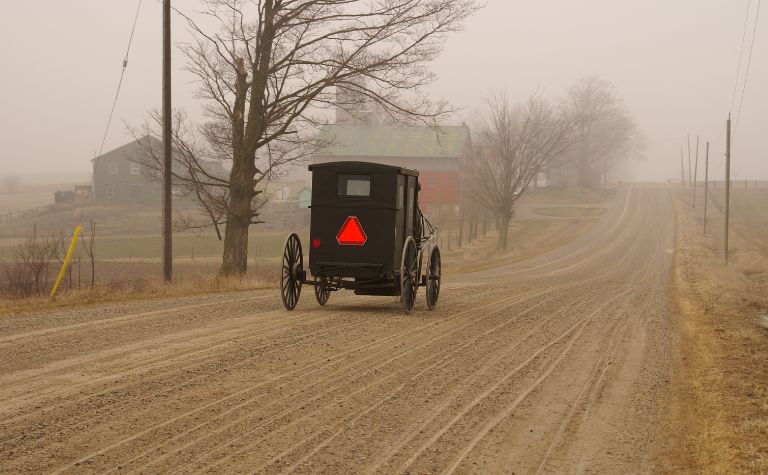Mennonites are followers of the anabaptist branch of Christianity. To this day, they remain conservative in regard to their traditions and lifestyle.
Mennonites wear bonnets as part of their religious tradition. The Bible commands women to cover their heads when praying, and by the mid-19th century, bonnets had become the standard headwear for Mennonites. A black bonnet represents modesty, submission, and honoring God.
Most Mennonite traditions and practices revolve around serving and honoring God, being humble and modest, and not offending God by attracting attention. This reasoning was also used to justify the requirement for women to cover their hair. Bonnets are now mostly worn for church prayers, and only in the most traditional communities are they still required. [1]
Also see Why Do Mennonites Wear Black Hats? to learn more.

What Color of Bonnets Do Mennonites Wear?
Mennonites typically wear black bonnets because black is the traditional color for Mennonite women’s hair coverings. However, in some communities, women wear white bonnets to indicate that they are married, whereas unmarried women wear black.
Bonnets became a part of Mennonites’ prescribed costume for women at a time when this was a widespread practice. Women of some religious communities used to cover their hair, and many wore bonnets, which became popular in the 18th century.
However, by the late 19th century, fashion had begun to change, and bonnets started disappearing as women gave their preferences to hats. Unlike modest bonnets, hats came in a variety of shapes and sizes, and they were typically enhanced with flowers, feathers, and other decorations.
Anabaptists did not generally accept this. Mennonites and Amish, religious communities that are very firm in following their traditional ways, did not approve of the hats, which were seen as a sign of women’s emancipation and a betrayal of the idea of submission and modesty. [2]
Mennonites insisted on humble black bonnets as a mandatory women’s headdress, as opposed to the colorful and appealing hats of the new fashion.
At first, this fight against hats and the prescription of black bonnets disrupted the community. Many women resisted wearing bonnets to church and hats in social and professional settings.
However, before bonnets became fashionable, Mennonite women wore flat hats to cover their hair. There are also no biblical mandates for bonnets; the verses only state that women’s heads should be covered when praying.
Therefore, the persistence in wearing bonnets as women’s primary headwear was not dictated by their faith but rather by a desire to stick to the old ways. It demonstrates how important tradition is to Mennonite communities.
Today, wearing black bonnets is usually limited to church visits. In more traditional communities, however, women still wear them every day. Mennonites and Amish women also practice wearing white bonnets once they are married to show they are no longer single.
Also see How Do Mennonite Women Dress? to learn more.

What Size of Bonnets Do Mennonites Wear?
Today, Mennonite women wear small bonnets, barely covering their hair. They are typically about 24 inches (60.96 cm) wide, but they may be even tinier in less conservative communities.
Bonnets have shrunk significantly in size over the years. When they first became popular in the 18th century, they were much bigger and had a cape in front.
These larger bonnets completely covered the head from the back and were tied by strings under the chin. The fabric would usually extend down to the neck and shoulders to cover them.
When fashion started to change, so did bonnets. Women who still wore them made adjustments, so they didn’t look too old-fashioned. They would leave the ties hanging or get rid of them altogether.
Shops that sold bonnets also kept reinventing them. It started with the gradual disappearance of the cape. Then ties were replaced by a band and clasp.
The size of bonnets also kept getting smaller and smaller until they became ‘beanie-type’ bonnets that looked more like the hats women usually wore in the 20th century. [3]
Though church bonnets remained more traditional, they saw a similar change. Their gradual shrinking resulted in many women and sometimes whole Mennonite communities abandoning them in favor of simple dark hats.
Modern-day bonnets do not resemble those of the Victorian era. They are small and only cover the back of the head. Many Mennonite communities do not require wearing bonnets even for church; women use light head coverings instead.
In some communities, the coverings have shrunk to the size of a dollar coin; in others, coverings are no longer necessary.
Also see How To Tell If A Mennonite Woman Is Married to learn more.

Do Bonnets Have Symbolic Meaning to Mennonites?
Wearing bonnets symbolizes modesty, submission, and obedience to God’s order of authority. Bonnets are also meaningful as a tradition that has been in Mennonites’ culture and faith practice for centuries.
The main ideas that have always stood behind Mennonite beliefs, practices, and lifestyle include:
- Humility
- Serving God
- Not attracting too much attention
- Following tradition
The practice of wearing bonnets is a part of that way of life. The Bible states that women should cover their heads when praying, whereas men are required not to do so. It can be found in 1 Corinthians 11:1-34. [4]
‘Every man who prays or prophesies with his head covered dishonors his head, but every wife who prays or prophesies with her head uncovered dishonors her head since it is the same as if her head were shaven.‘ (11:4-5)
‘But if a woman has long hair, it is her glory: For her hair is given to her for a covering.’ (11:15)
However, the way women’s hair must be covered is never specified. That is why the requirement to wear bonnets is purely traditional. As mentioned, bonnets were prescribed as an essential element of women’s appearance in opposition to fashionable hats, and in that context, they symbolized modesty.
Today, wearing bonnets for Mennonites symbolizes respect for the traditional ways, honoring God’s order of authority, and being humble, modest, and submissive. It also represents belonging to the community and being a member of the group.
Conclusion
Traditionally, Mennonites wore bonnets to symbolize submission and modesty. The practice still exists in conservative Mennonite communities.
Also see Do Mennonite Women Wear Pants? to learn more.
References:
[1] Source
[2] Source
[3] Source
[4] Source
Related Questions
Both Amish and Mennonites are descendants of the Anabaptist movement and share many of the same values. However, the rules they live by vary in some important ways, such as those governing their...
The Amish are a Christian community, found mostly in America today, with roots in 17th-century Switzerland. Amish people are known for their appearance and simple lifestyle that rejects many modern...
